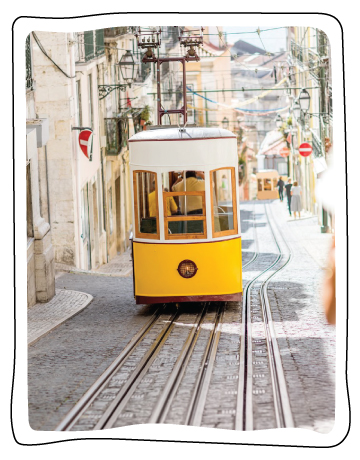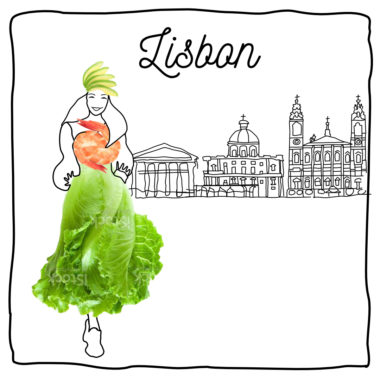Friendly disclaimer!
We want to be as accurate as possible, but given these challenging times, we urge you to recheck that the venues are open when you decide to visit.
Being the second oldest city in Europe, Lisbon combines a millennium of European history with modern innovation and creativity. Portugal’s naval advancements and successes in exploration and trading have been immortalized in the various churches, monuments and palaces that are scattered throughout the city.
Panoramic hillsides overlooking the Tagus River, a bounty of fresh seafood, cheap booze and the much sought after Fado performances provide ample opportunities to indulge in the capital’s diverse culture on our three-day itinerary for Lisbon.
Lisbon 3-day itinerary at a glance
Day 1 Baixa, Alfama and Graça
Begin your first day in Lisbon at the historic Rossio Square, where you can visit the National Theatre and the iconic Rossio Railway Station. A short walk from the square takes you to the Santa Justa Lift, an architectural and engineering marvel from the early 20th century. Stroll through the Rua Augusta to the picturesque Praça do Comércio on the banks of river Tagus. Next, head to the Lisbon Cathedral, known for its Gothic cloisters. Visit the Museu do Fado which showcases the history of Portuguese Fado and spend the rest of your evening partying at the famed LuxFrágil.
- Rossio Square
- Santa Justa Lift
- Praça do Comércio
- Lisbon Cathedral
- Museu do Fado
- Viewpoint at Largo das Portas do Sol
- LuxFrágil
Day 2 Sintra and Bairro Alto
Take the day to visit the Sintra district and its panoramic palaces and parks. Start your day with Romantic architecture at the Monserrate and the Pena National Palace and park. The Castelo dos Mouros offers a historic experience of Sintra through its archaeological treasures. Spend your evening roaming the gardens at the National Palace of Sintra. Followed by a visit to the mysterious Regaleira estate. Call it a day while exploring the vibrant neighbourhood of Bairro Alto.
- Monserrate
- Pena National Palace
- Castle of the Moors
- National Palace of Sintra
- Quinta da Regaleira
- Bairro Alto
Day 3 Belém
Spend your last day in Lisbon touring Belém. Start at the Belém Tower and the Jerónimos Monastery to explore the Naval power of Portugal in the 16th century. Make your way to Pastéis de Belém and try their unmatched sweet pastries made using an ancient secret recipe once followed by the monks at Jerónimos Monastery. Spend the rest of your day at some of Lisbon’s most creative areas including the shopping hub at LX Factory and the Time Out Market where you can sample the best of Portuguese cuisine. Enjoy your final hours in Lisbon watching a beautiful yet melancholic Fado performance over dinner at some of the best Fado venues in the city.
- Torre de Belém
- Jerónimos Monastery
- Pastéis de Belém
- LX Factory
- Time Out Market
- Pink Street
- Catch a Fado Show
Detailed 3-day Lisbon itinerary
Day 1
Explore Rossio Square

Municipal House has captured the true essence of Art Nouveau and is a remarkable expression of quality and craftsmanship. Decorated by some of Europe’s most talented artists, visit the different halls, restaurants and the café of the building to lose yourself in its art nouveau interiors.
Things to do:
- Column of Pedro IV: The 27-meters (89ft) tall King Pedro IV monument stands in between two prominent Baroque fountains in the centre of the square.
- Dona Maria II National Theater: Standing on what was once the Estaus palace, the National Theatre of Portugal welcomes visitors with an enchanting neoclassical façade. Today, the historic theatre puts on performances and offers guided tours to all those who wish to walk its halls.
- Rossio Railway Station: Next to the National Theatre is the striking Rossio railway station which stands apart due to its unique and well-preserved horseshoe-shaped entrance inspired by neo-Manueline 16th-century Portuguese palaces.
- Grab a cup of coffee at Café Nicola: Among the oldest Cafés in Lisbon, Café Nicola offers a traditional Portuguese coffee experience in its Art Deco interiors and façade, decorated and frequented by none other than Portuguese poet Bocage.
- Church of St. Dominic and the Jewish Memorial: Classified as a national monument and seat of the Inquisition, the Church of St. Dominic is a very unusual church to say the very least, with its harrowing depictions of Jesus’s death and corpse. The Jewish Memorial stone at its entrance reads “Lisbon, city of tolerance” as a tribute to the Jewish massacre of 1506 which occurred in front of the church.
Useful Information:
- Location: Praça do Rossio
- Timings: Always open
- Cost: Free entry
- How to Reach:
-
- Metro: Metro: Rossio (green line)
- Bus: Rossio (207, 711, 732, 736, 746, 759, 783, 794)
- Tram: Pç. Figueira (tram 12E, 15E, 25E)
Ride the Santa Justa Lift

Celebrated in 1902 as one of Lisbon’s most prominent transportation systems, Carmo Lift, later renamed as Santa Justa Lift, is a popular tourist attraction today. Decorated in theNeo-Gothic styles with geometric patterns and beautiful arches in wrought iron, the lift and its viewing platform offer a picturesque view of the city skyline.
Unravelog Tip: Buy the Carris/Metro 24-hour ticket for €6.40 and you can ride the Santa Justa lift and use the Carris metro facilities for a whole day without paying extra.
Useful Information:
- Location: R. do Ouro
- Timings:
-
- Summer (May- October): 7:00 am- 11:00 pm
- Winter (November- April): 7:00 am- 10:00 pm
- Cost:
-
- Elevator and Return: €5.15
- Viewing platform (no elevator): €1.50
- How to Reach:
-
- Metro: Rossio (green line)
- Bus: Rossio (207, 711, 732, 736, 746, 759, 783, 794)
- Tram: Pç. Figueira (tram 12E, 15E, 25E)
Visit the Praça do Comércio

Facing the Tagus River and surrounded by 18th-century canary-yellow administrative buildings, the Praça do Comércio (Commerce Square) is one of the most magnificent squares in Lisbon. It was built on the site where the old Royal Palace used to exist before it was destroyed by the earthquake of 1755.
Things to do:
- At the centre of the square, find the bronze equestrian statue of Joseph I, the King of Portugal during the 1755 earthquake.
- Climb up the Rua Augusta Arch for €2.50 and gaze at stunning views of the square, the Tragus river and Rua Augusta. This triumphal arch celebrates the reconstruction of Lisbon after the earthquake.
- Visit the Lisboa Story Centre to recount the city’s history through its innovative and engaging exhibits.
Useful Information:
- Location: Praça do Comércio
- Timings: Always open
- Cost: Free entry
- How to Reach:
-
- Metro: Terreiro do Paço (blue line)
- Bus: Pç. Comércio (206, 207, 208, 210, 706, 714, 728, 732, 735, 736, 760, 774, 781, 782)
- Tram: Pç. Comércio (tram 15E, 25E)
Tour the Lisbon Cathedral
Dating back to 1147, the Lisbon Cathedral (Sé de Lisboa), also known as the Church of Santa Maria Maior, is the oldest church in the city. This predominantly Romanesque cathedral survived many natural disasters including the earthquake of 1755. and was subject to several renovations and reconstructions over the centuries.
Things to do:
- Enter the Cathedral’s cross-shaped walkway to come across the three naves and a transept leading to a beautiful portrayal of the Last Supper by Pedro Alexandrino.
- In the cloisters, discover ancient ruins dating back to 4 BC over which the Cathedral was built.
- Take a look at the church’s treasury where you can find priceless relics, jewels, manuscripts and sculptures.
Useful Information:
- Location: Largo da Sé
- Timings:
-
- Cathedral: 9:00 am- 7:00 pm.
- Cloister:
- October- April: 10:00 am- 6:00 pm (Sunday 2:00 pm onwards).
- May- September: 10:00 am- 7:00 pm.
- Treasury: 10 am to 5 pm (closed on Sundays).
-
- Cost:
-
- Cathedral: Free entry
- Cloister: €2.50
- Treasury: €2.50
- Cloister and treasury: €4
- 50% discount for students and free for children under 11
- How to Reach:
-
- Metro: Terreiro do Paço (blue line)
- Bus: Sé (737), Pç. Comércio (206, 207, 208, 210, 706, 714, 728, 732, 735, 736, 760, 774, 781, 782)
- Tram: Sé (28E), Pç. Comércio (tram 15E, 25E)
Browse through Museu do Fado
The Museu do Fado has been documenting the journey of Fado (a traditional music genre that has its roots in Lisbon) since it opened in 1998. Discover the history of this timeless art form through a series of audiovisual recreations and a rich collection of records, photographs, films, props and various other instruments and objects.
Things to do:
- Browse through the collections and exhibitions that outline the history of Fado in Europe through a guided tour of the Museum circuit;
- If you are interested in vocal music, make sure to attend the Sing Fado workshop and try your hand at Fado singing;
Attend a Fado concert hosted by the museum.
Useful Information:
- Location: Alfama, Largo do Chafariz de Dentro 1
- Timings: Tuesday–Sunday: 10:00 am–6:00 pm.
- Cost:
-
- Regular rate: €5.
- People over the age of 65 and the disabled: €4.30.
- Youth aged 13-25: €2.50.
- Free entry for children aged 0-12.
-
- Website: https://www.museudofado.pt/en
- How to Reach:
-
- Metro: Terreiro do Paço (blue line), Estação de Santa Apolónia
- Bus: Alfândega (206, 210, 728, 735, 759, 794), Miradouro Sta. Luzia (737)
- Tram: Miradouro Sta. Luzia (12E, 28E)
Enjoy the views at Largo das Portas do Sol

The viewpoint at Largo das Portas do Sol offers visitors a scenic view of the Tagus river beyond Alfama’s scattered red rooftops. Portas do Sol (which means ‘Door of the Sun’) is now a square with a terrace from where you can sit, relax and enjoy a leisurely drink with a view.
Useful Information:
- Location: Largo das Portas do Sol
- Timings: Always open.
- Cost: Free entry.
- How to reach:
-
- Metro: Metro: Terreiro do Paço (blue line), Estação de Santa Apolónia.
- Bus: Largo das Portas do Sol (712, 728, 732, 734, 737, 759).
- Tram: Largo das Portas do Sol (tram 28E)
Experience Lisbon’s Nightlife at LuxFrágil

Undoubtedly one of the best places in Lisbon for a good night out, the world famous LuxFrágil, offers the ultimate nightclub experience. Dance to the tunes of the DJ, chill like a royal on its throne-like chairs or simply take in the picturesque views over the Tagus from its rooftop terrace. LuxFrágil guarantees a good time.
Useful Information:
- Location: LuxFrágil
Day 2
Visit the Monserrate Palace
Praised throughout history particularly in British travel accounts, the Monserrate palace and park is considered to be an impressive example of Romantic architecture. Commissioned by English millionaire and architect Sir Francis Cook, the Monserrate park is home to thousands of exotic plant species.
Things to do: Explore different parts of the Monserrate palace premises, including the garden, main hall, gallery, library, music room and the chapel.
Useful Information:
- Location: Rua Parque de Monserrate
- Timings:
-
-
- Palace: 9:30 am- 6:30 pm.
- Park: 9:00 am- 7:00 pm.
-
- Cost:
-
- Regular rate: €8.
- Youths aged 6-17: €6.50.
- Seniors aged 65+: €6.50.
- Families (2 adults and 2 youths): €26.
- Free entry for children aged 0-6.
- Website: https://www.parquesdesintra.pt/en/parks-monuments/park-and-palace-of-monserrate/
Discover the Pena National Palace

The Palácio Nacional da Pena is a renowned architectural creation of 19th-century Romantic revivalism amidst the lush Sintra Hills. Built in an eclectic revival style incorporating neo-Gothic, neo-Manueline, neo-Islamic and neo-Renaissance elements, the Palace is a highly celebrated Romantic marvel today.
Things to do: Discover the different parts of the complex including the Manueline Cloister, the Chambers of King Carlos, Queen’s terrace, Great hall and the Camellia garden.
Useful Information:
- Location: Parque e Palácio Nacional da Pena
- Timings:
-
-
- Palace: 9:30 am- 6:30 pm
- Park: 9:00 am- 7:00 pm
-
- Cost:
-
- Park:
- Regular rate: €7:50.
- Youths aged 6-17: €6.50.
- Seniors aged 65+: €6.50.
- Families (2 adults and 2 youths): €26.
- Park + Palace:
- Regular rate: €14.
- Youths aged 6-17: €12.50.
- Seniors aged 65+: €12.50.
- Families (2 adults and 2 youths): €49.
- Free entry for children aged 0-6.
- Park:
- Website: https://www.parquesdesintra.pt/en/parks-monuments/park-and-national-palace-of-pena/
Catch the views from the Castle of the Moors

The Castelo dos Mouros was built under Islamic rule millennia ago, as a defence strategy against attacks from land and air. Apart from the astounding array of archaeological artefacts showcased for visitors inside the complex, the castle also boasts picturesque views of the surrounding hills, the Pena Palace and the Atlantic Ocean in the distance.
Things to do: Explore the prominent parts of the castle including the silos, the Islamic neighbourhood, the tombs, the Church of São Pedro de Canaferrim and the Door of Betrayal.
Useful Information:
- Location: Castelo dos Mouros
- Timings: 9:00 am- 6:30 pm.
- Cost:
-
- Regular rate: €8.
- Youths aged 6-17: €6.50.
- Seniors aged 65+: €6.50.
- Families (2 adults and 2 youths): €26.
- Free entry for children aged 0-6.
- Website: https://www.parquesdesintra.pt/en/parks-monuments/the-moorish-castle/
Explore the National Palace of Sintra

In the centre of Sintra with its unique conical chimneys is the National Palace of Sintra, dating back to the 10th or 11th century, when Sintra was under the rule of the Moors. Incorporating Medieval, Gothic, Manueline, Renaissance and Romantic architectural styles, the palace complex has been subject to several reconstructions throughout the centuries.
Things to do: Explore the Palace’s gallery room, room of the Coat of Arms, chapel, patio and gardens.
Useful Information:
- Location: Largo Rainha Dona Amélia
- Timings: 9:30 am- 6:30 pm.
- Cost:
-
- Free entry for the garden.
- Palace:
- Regular rate: €10.
- Youths aged 6-17: €8.50.
- Seniors aged 65+: €8.50.
- Families (2 adults and 2 youths): €33.
- Free entry for children aged 0-6.
- Website: https://www.parquesdesintra.pt/en/parks-monuments/national-palace-of-sintra/
Visit the mystical gardens at Quinta da Regaleira
Designed by Italian set-designer and architect Luigi Manini, Quinta da Regaleira is a four-hectare estate of Gothic, Roman, Manueline and Renaissance styles. The main highlight of the villa is however the enchanting and ornate gardens that surround the property, with hidden caves, ornate statues and mystical symbolism.
Things to do: The estate is famous for its iconic Initiation well, with a spiral staircase that descends into it and inscriptions of a templar cross on the floor.
Useful Information:
- Location: R. Barbosa du Bocage 5
- Timings: 10:00 am- 6:30 pm.
- Cost:
-
- Self-Guided Visit:
- Regular rate: €10.
- Youths aged 6-17 and seniors aged 65-79: €5.
- Families (2 adults and 4 youths): €25.
- Free entry for those aged 0-5 and 80+ and the disabled.
- Guided Visit:
- Regular rate: €15.
- Youths aged 6-17 and seniors aged 65-79: €8.
- Families (2 adults and 4 youths): €45.
- Free entry for those aged 0-5 and 80+ and the disabled.
- Self-Guided Visit:
- Website: https://www.regaleira.pt/en
Go partying at Bairro Alto

Spend the rest of your evening at the Bairro Alto neighbourhood, home to Lisbon’s historically prominent funiculars and a long line of pubs and clubs such as Foxtrot and Capela.
Things to do: Explore the neighbourhood’s live music scene (including Fado),with a visit to Tasca do Chico, which is one among the 8 spots to enjoy Fado in Lisbon) and party with people from all over the world.
Unravelog Tips:
- Make sure to carry cash with you, as most places in Bairro Alto don’t accept cards
- You can continue to party after Bairro Alto at Pink Street and Rua de São Paulo.
Useful Information:
- Location: Bairro Alto
Day 3
Visit Torre de Belém

Designed in the Manueline style in the early 16th century, the Belém Tower is a UNESCO World Heritage site that was built for naval defence. Watchtowers of the Arabic style decorate this impressive tower, which was also incidentally the first-ever spot in Europe where one could find carvings of the rhinoceros.
Useful Information:
- Location: Av. Brasília
- Timings:
-
-
- May- September: Tue-Sun, 10:00 am to 6.30 pm.
- October- April: Tue-Sun, 10:00 am- 5:30 pm.
- Cost:
- Regular rate: €6.
- Seniors aged 65+: 50% discount.
- Combined rate (Torre de Belém + Jerónimos Monastery): €12.
- Free entry for children aged 0-12.
-
- How to reach:
-
- Bus: Lg. Princesa (lines 27, 28, 29, 43, 49, 51 and 112).
- Tram: Lg. Princesa (tram 15E).
Stroll through the Jerónimos Monastery
Established in the early 16th century, the monastery of the order of St. Jerome is a UNESCO World Heritage site that is home to the tombs of Portuguese explorer Vasco da Gama and poet Luís de Camões. The monastery was designed in the Manueline style marking the return of Vasco da Gama back to Portugal from India.
Things to do:
- Visit the Church of Santa Maria, famous for its unique interior comprising a single nave that is supported by six columns.
- The monastery’s cloister is highly decorated with stoneworks of corals, ropes and legendary sea monsters that represent the Age of Discovery and Portugal’s success at sea.
Useful Information:
- Location: Praça do Império
- Timings:
-
-
- May- September: Tue- Sun, 10:00 am to 6:30 pm.
- October- April: Tue- Sun, 10:00 am to 5:30 pm.
- Cost:
- Church: free entry.
- Cloister:
- Regular rate: €10.
- Senior aged 65+: 50% discount.
- Free entry for children aged 0-12.
- Free entry on the first Sunday of every month.
-
- How to reach:
-
- Bus: Mosteiro Jerónimos (lines 727, 28, 729, 714, 751).
- Tram: Mosteiro Jerónimos (tram 15E).
Try the Pastries at Pastéis de Belém
Following the age-old sweet pastry recipe followed by the monks at Jerónimos Monastery, the Pastéis de Belém opened its doors to visitors in 1837. Essentially, a flaky puff pastry with an egg custard filling, they are a popular dessert in Portugal with the best ones made by hand using traditional methods at Pastéis de Belém, thanks to their time-honoured secret recipe.
Useful Information:
- Location: R. de Belém 84 92
- Timings: Monday- Sunday, 8:00 am- 8:00 pm.
- Website: https://pasteisdebelem.pt/en/
- How to reach:
-
- Bus: Mosteiro Jerónimos (lines 727, 28, 729, 714, 751).
- Tram: Mosteiro Jerónimos (tram 15E).
Go on a shopping spree at LX Factory
Below the city’s emblematic 25 de Abril Bridge is the LX Factory, one of the most creative areas in the city. What was an abandoned factory is now a bustling location with restaurants, galleries, tattoo shops, antique stores, fashion boutiques and bookstores, with amazing street art installations all around the area.
Things to do:
- Find your favourite books, hunt for instagrammable nooks or shop for unique finds amidst the many clothing, antique and book stores here.
Grab something to eat at the several restaurants that line the place. At Taberna 1300, you can also indulge in a wine tasting session.
Useful Information:
- Location: R. Rodrigues de Faria 103
- Timings: Daily.
- Cost: Free entry.
- Website: https://lxfactory.com/en/lx-factory/
- How to reach:
-
- Bus: Calvário (lines 201, 720, 714, 727, 732, 73B, 738, 742, 751, 756, 760).
- Tram: Calvário (tram 15E, 18E).
- Metro: Alcantara Mar.
Indulge in Portuguese cuisine at the Time Out Market

The historic Mercado da Ribeira was transformed into this popular food hub by Time Out magazine. Taste budget-friendly samples from its many intriguing stalls while grooving to live music at the world’s first curated food market that brings together the best bars, restaurants and cultural experiences under one location. Here’s a list of the 14 must-try dishes in Lisbon.
Useful Information:
- Location: Mercado da Ribeira
- Timings: Monday- Sunday: 10:00 am- 10:30 pm.
- Cost: Free entry.
- How to reach:
-
- Bus: Cais Sodré (lines 201, 207, 208, 210, 706, 728, 732, 736, 758, 760, 781).
- Tram: Cais Sodré (tram 15E, 18E).
- Metro: Cais do Sodré (green line).
Visit the iconic Pink Street

Once the red light district of Lisbon, the Rua Nova do Carvalho was completely revamped in 2011 and became ‘Rua Cor de Rosa’- one of the coolest spots in the city with bars, restaurants and its iconic pink-coloured streets.
Things to do: Spend the evening clicking pictures of the iconic street, trying wine, cocktails or brews and dancing the night away at the many live music clubs here.
Useful Information:
- Location: R. Nova do Carvalho 24
- Timings: Always open.
- Cost: Free entry.
- How to reach:
-
- Bus: R. S. Paulo (lines 714, 774), R. Alecrim (lines 22B, 202, 758), Cais Sodré (lines 201, 207, 208, 210, 706, 728, 732, 736, 758, 760, 781).
- Tram: R. S. Paulo (tram 25E), Cais Sodré (tram 15E, 18E).
- Metro: Cais do Sodré (green line).
Enjoy a Fado Show

Fado has been around in Lisbon since around the 1820s as an expression of mournful lyrics through music, often revolving around the sea and the struggle of poverty. Watch a traditional Portuguese Fado performance at one of the top dining venues in the city such as Adega Machado, Club de Fado or Parreirinha de Alfama.
Unravelog Tip: Make sure to reserve a table ahead of time, as most Fado venues tend to be booked in advance.
Useful Information:
- Cost and Timings: Depends on the venue chosen.
The best way to truly understand a country’s identity, history and soul, is to tune in to its local music culture. And with Lisbon, immersing yourself in its historic Fado music is one of the best ways to do it. Here are 8 spots to enjoy Fado in Lisbon.























